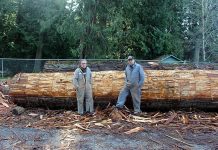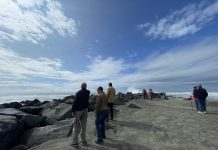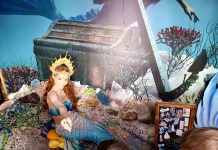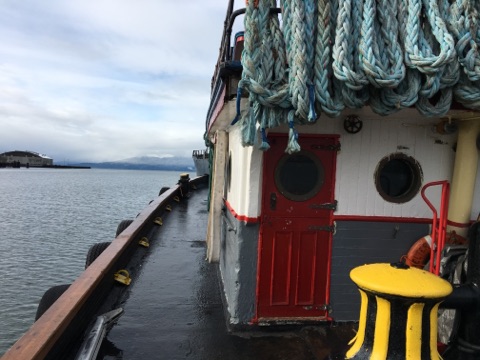Tom Tucker finds himself sleepless during storms in Bellingham Bay. He and his cat “Baby” nestle in behind the well-worn helm of the Cheryl Ann and listen closely to the tugboat’s night voices. As the wind pushes against the weathered Dutch doors of the captain’s quarters, he guards his celebrity boat like any good naval man would, maneuvering her solo through the rolling waves of the Pacific.
On stormy nights, Tucker tends to multiple systems in the engine room – sometimes in a masterful half-sleep. He knows her engine inside and out. He fires up the generator and makes sure his tug is ready to move in a moment’s notice, just in case the anchor chain should give way and the boat escape from its mooring buoy. When his experienced hands grasp the weathered spokes of the helm, he relies on years spent assuring a ship’s systems support her crew – even if that crew is now down to just one (plus a sleepy cat).

Built in the 1920s by a German-born boat maker, William Müller, the Cheryl Ann became the workhorse of San Pedro harbor in Los Angeles, California. That is until she was rediscovered in 1955 for a television show called, “Waterfront.” On the show, a tugboat captain and his family are supporting actors to the starlet found onboard – the Cheryl Ann herself. She was eventually sold to Salmon Bay Barge Lines in Seattle and Tucker found her for sale in Anacortes.
Since then, his tug has been anchored in Bellingham Bay. For just over four years, Bellingham’s South Side residents may have noticed her red stack bobbing a few hundred feet offshore. But few know the famous Cheryl Ann by her name or the story of her newest captain.
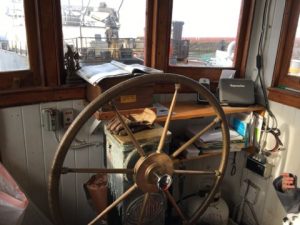
After retiring from the Navy, Tucker lived on a sailboat in the area for six years but said he became bored with the slow rhythm of his days. “After being an engineer on a ship, well this tug is just like an engineering plan on a ship,” he said. In the familiar, there’s comfort for Tucker who knows exactly how to manage the Cheryl Ann. His calendar is full of projects and ongoing maintenance. There’s a fresh coat of paint on the tug’s iconic stack, an attempt to shine her up to an original luster.
Previously, Tucker’s called many larger ships home – aircraft carriers all over the world. After enlisting in 1968, his first three tours were in-country on amphibious transports or landing craft. On the Saigon River, Tucker’s job was to pick up distressed boats that had been riddled with gunshot holes. During one mission, he was tasked with rescuing a PBR patrol boat – one that had originally been built in Bellingham by Uniflite.
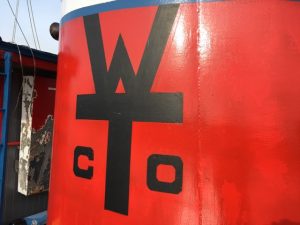
He was in the Persian Gulf during the Gulf War and was also on hand in Somalia in 1994, just before the ship he’d served on for eight years, the USS Ranger, was decommissioned. From 1981-84, and again in 1991 during the Gulf War, the Ranger was his world. During the 1970s era of gasoline shortages, he tried his hand at trucking. After realizing he was losing money due to the high cost of fuel, he sold his truck and returned to the Navy. He would work his way up to a Chief Electrician (E-7).
Many of the photos hanging in the captain’s bunkroom are of Tucker’s favorite ship, the USS Ranger. “It was the only ship I ever really liked,” he said. “I was on the Kitty Hawk for two tours and hated that thing. I would’ve rather have been shot at than be stuck on that aircraft carrier doing circles in the Tonkin Gulf. It was a piece of junk and it was an unhappy ship, the crew was always unhappy.” Tucker described the Ranger as the opposite kind of ship, “A dirty, old, horrid thing that the crew all liked and it always ran. It always worked.”
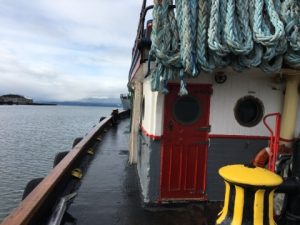
The Cheryl Ann is another boat that’s earned Tucker’s respect. In the small galley, the provisions hang in hammocks and the coffee is always on. “Coffee is the only thing that keeps me alive, I think. Actually, I think I died several years ago and it’s only the coffee that keeps me animated,” Tucker joked.
As a matter of fact, he could have died several times in the conflicts he’s witnessed. “I still have white spots all along my side from the fiberglass specs that came from that mission on the Saigon,” he said. His stripes and stars displayed on the wall depict his tours from a life of military service. In between those tours, there was a family and five children to raise along with subsequent losses. But there has also been renewal and a sense that Tucker is as salty as the seas he’s loved.
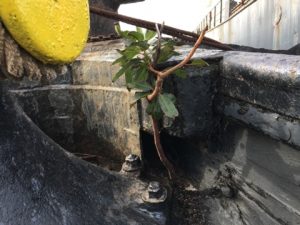
A small madrone sapling grows quietly on the deck near the anchor line of the Cheryl Ann. The tree has taken up residence in the wood between the tarred floorboards of the deck. Tucker admits he can’t bring himself to pluck it out and every time he brings the anchor in, the tree loses a few more of its’ new branches. Perhaps the feisty captain is akin to the tree. He’s lost some of his limbs over the years (three of Tucker’s biological children have died) and he’s had to carry the weight of war. However, throughout his life, he’s found an independent spirit and an engineering mind to carry him through. Just like the sapling, he’s bound to flourish in even the most unexpected of landscapes.
As the seagulls call distantly, Tucker looks to the south and says, “This summer I was thinking about heading down the coast, spending my next winter down in Newport, Oregon.” Tucker plans to eventually find a good home for the Cheryl Ann. He’d like to return her from whence she came, back to Southern California and to the Los Angeles Maritime Museum where others can appreciate her lustrous history. He thinks of buying a big spread of land somewhere in the Nevada desert, building a house and riding out his retirement from the back of his motorcycle, in the quiet of an altogether different expanse.




